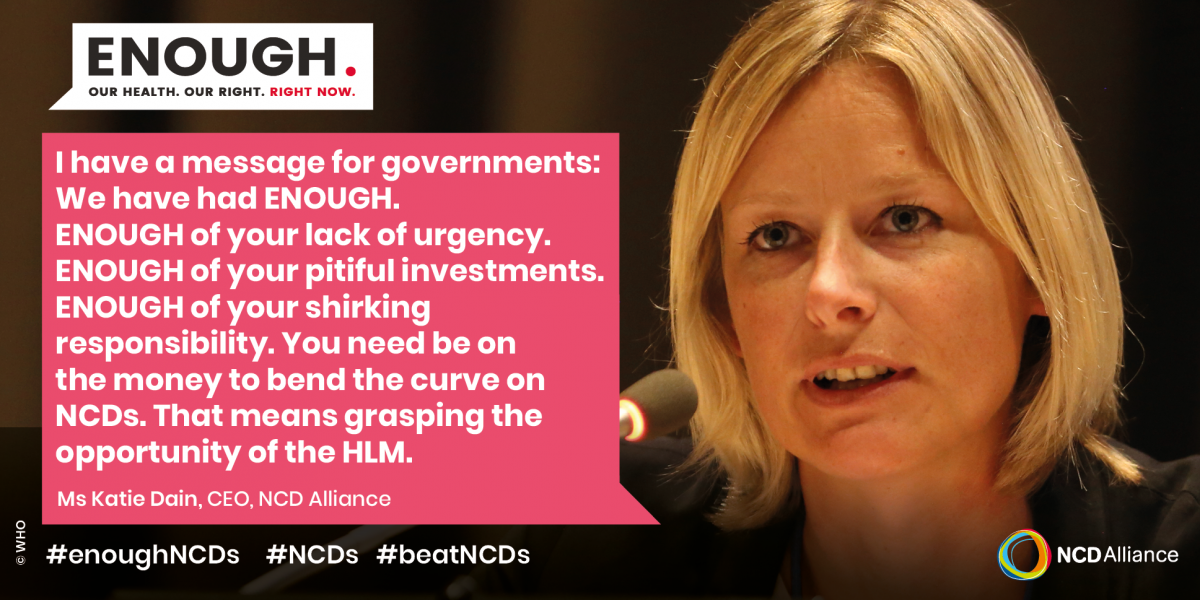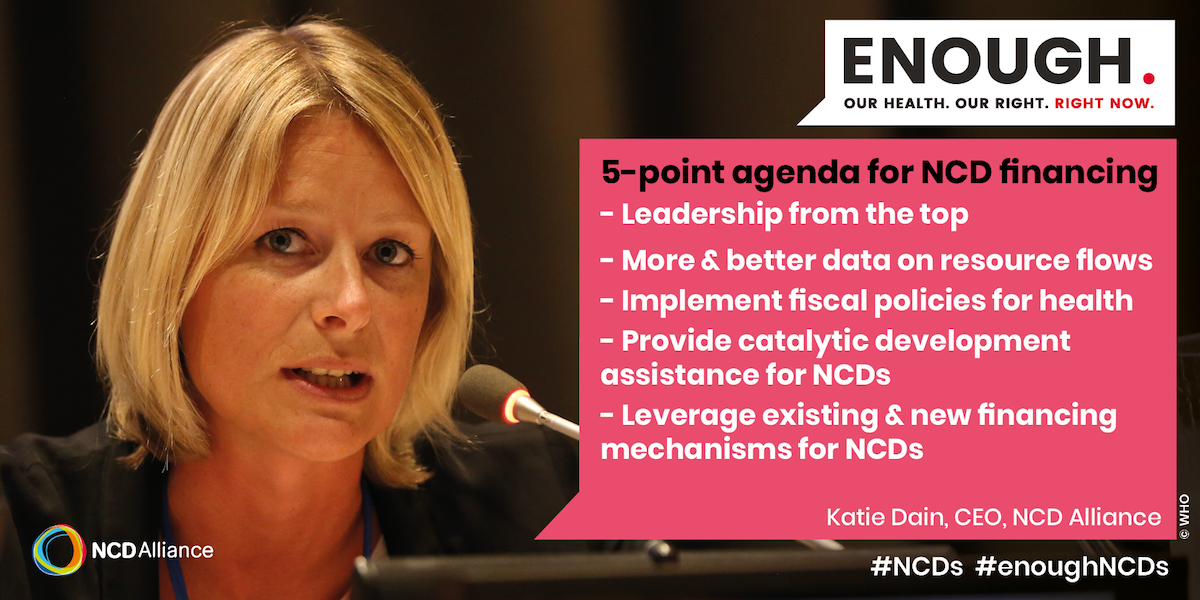
This speech was delivered by Katie Dain, CEO of NCD Alliance, during a panel on NCD financing at the Interactive Hearing in Preparation for the 2018 High-Level Meeting on NCDs. “What does civil society see as being the opportunities for countries to scale up financing for NCDs?”
5 July 2018, New York:
Today, we are just 84 days away from the third UN HLM on NCDs. And we have 4,580 days to realise the Sustainable Development Goals. If we are to make the next HLM a success, and give governments a fighting chance to attain the NCD-related SDGs, we need to take a hard look at financing.
In 2018 we know three defining facts on NCD financing:
-
The current level of investment in NCDs is pitiful – less than 1 billion USD a year of DAH is allocated to NCDs.That’s peanuts when compared to HIV/AIDs, which receives 9 times that amount; and is simply inconsequential when compared to the annual investments made in global military expenditure, totalling 1.7 trillion dollars.
-
Economies are being depleted by the direct and indirect costs of NCDs. Annual GDP losses range from 3.5% – 5.9%, and the amount it will have cost developing countries alone between 2011 and 2025 will be $7 trillion dollars, equivalent to the combined GDP of France, Spain and Germany last year.
-
The return on investment in NCDs significantly outweighs the costs. NCDs for too long have beenbranded as an expenditure, when many of the Best Buys are in fact low cost, affordable for every country, and represent a smart and strategic investment. For every dollar invested in NCDs, there will be a return to society of at least $7 in increased employment, productivity and longer life. The bottom line for governments is clear: invest now, save later.
As civil society organisations, we are all too familiar with the real and devastating consequences of this political inertia and frankly irresponsible and unethical level of investment in NCDs today. As a result, millions more people and communities will have lost loved ones to avoidable death. Millions more will have witnessed the carnage of amputations and disability through lack of diagnosis and treatment. Millions more will have struggled with entrenched poverty caused by catastrophic out of pocket expenditures.
But as always, as civil society we are not just here to bemoan the current crisis. We are here armed with concrete solutions and recommendations, based upon sound evidence and experience.
Today we have a 5-point agenda on financing for NCDs, that we urge you to consider for the HLM:
-
Leadership from the very top: If this Political Declaration does not include a strong commitment from Heads of Government and State to provide decisive, inclusive and accountable leadership and stewardship on NCDs, we will simply have failed. This is a prerequisite for financing. We all know that Ministers of Health don’t control the purse strings. Nor do they have the power to mobilise a whole-of-government response, where all governments departments are accountable, have budget lines for NCDs, and are coherent in their policies. The Heads, and only the Heads can do this.
-
More and better data on resource flows: Current data on domestic resource flows is extremely poor and patchy for NCDs, with only 26 countries reporting NCD specific expenditure between 2010 and 2016. Improvement in the collection and use of domestic spending data, and inclusion of NCDs in national health accounts is vital to better target investments at populations in need, and to improve efficiency in the delivery of services.
-
Implement fiscal policies for health: A powerful fiscal policy that governments have at their fingertips is raising taxes on sugar-sweetened beverages, tobacco and alcohol (referred to as STAX). STAX are gaining more attention as an indispensable policy tool to improve public health, save lives, and generate resources to invest in health andsustainable development. Despite what industry and some governments may say, there is sufficient evidence of their impact in reducing consumption and being pro-poor. And the sheer number of countries that have implemented taxes is testament to their effectiveness, increasingly making taxes the norm rather than the exception.
-
Provide catalytic development assistance for NCDs: Although domestic resource mobilisation is important, we have to be realistic with the 30 low-income countries,who allocate less than 5% of GDP to health. It is unreasonable to expect progress on NCDs without catalytic funding from donors. And this is where the $1 billion development assistant currently invested in NCDs is farcical and unethical. We call upon the donor governments to step up, integrate NCDs into existing priorities, and respond to the many calls from low-income countries for support on NCDs.
-
Leveraging existing and new financing mechanisms for NCDs: For too long, the NCD community has been too polite with our demands for shaking up the global health architecture, which has shaped priority setting and resource flows. While we stick to our position that we do not want to see a new Global Fund for NCDs, after 10 years of glacial progress we want to see tangible commitments that the Global Fund, the Global Financing Facility, and UNITAID are serious about integrated approaches and addressing NCD co-morbidities. And we expect governments to be bold and explore new financing mechanisms dedicated to NCDs, such as the multi-partner trust fund for NCDs that was included in both the WHO High-Level Commission report and the recent Inter-Agency Task Force on NCDs resolution.
To end, I have one message for governments.
We have had enough. Enough of your lack of urgency. Enough of your pitiful investments. Enough of your shirking responsibility. You need be on the money to bend the curve on NCDs. And that means grasping the opportunity of the HLM, and going beyond the generic language previously agreed on financing to make concrete, tangible commitments. If you don’t this time around, the price is clear: 120 million lives lostprematurely from NCDs between now and 2025.

***END***
Visit enoughncds.com and get involved in the NCDA campaign asking world leaders to stop much of the preventable suffering and deaths from NCDs. We know the solutions. It is time for leadership and meaningful action.

